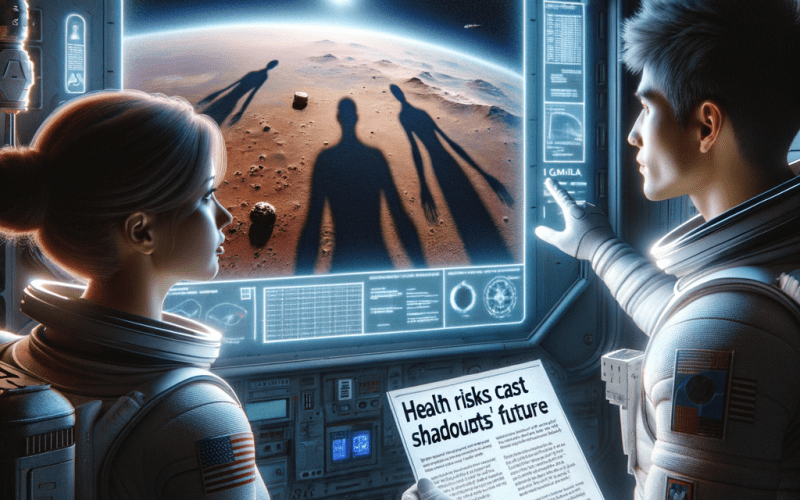Introduction
The allure of Mars, our celestial neighbor, has long captivated the imagination of scientists, explorers, and the general public alike. The prospect of a human mission to the Red Planet has been a topic of fervent discussion for decades, promising unprecedented scientific discoveries and the expansion of human presence beyond Earth. However, recent revelations about the profound effects of space travel on the human body have cast a pall over this endeavor, raising serious doubts about the feasibility of a manned mission to Mars.
The Perils of Space Travel
Extended exposure to the harsh conditions of space poses grave risks to human health. Astronauts aboard the International Space Station (ISS) have endured an array of adverse effects, including:
- Bone loss: Weightlessness in space leads to accelerated bone demineralization, weakening bones and increasing the risk of fractures.
- Muscle atrophy: Prolonged disuse of muscles in microgravity causes significant loss of muscle mass and strength.
- Radiation exposure: Space is awash with cosmic radiation, which can damage DNA, increase cancer risk, and compromise cognitive function.
- Immune system suppression: The immune system becomes weakened in space, making astronauts more susceptible to infections and diseases.
- Psychological strain: Isolation, confinement, and the challenges of space travel can take a heavy toll on astronauts’ mental health.
Prolonged Voyages to Mars: A Recipe for Disaster
The challenges of space travel are amplified during prolonged voyages to distant destinations like Mars. A round-trip mission to the Red Planet would span approximately two to three years, subjecting astronauts to an unprecedented level of cumulative exposure to the hazards mentioned above.
The journey alone would entail a minimum of nine months, exposing astronauts to the bone-weakening effects of microgravity for an extended period. This would significantly increase the risk of fractures and mobility impairments upon arrival at Mars.
Furthermore, the vastly increased distance from Earth would result in higher radiation exposure levels. Astronauts would be subjected to a constant barrage of cosmic radiation, potentially leading to increased cancer risk and long-term health consequences.
The psychological strain of a prolonged mission to Mars is also a major concern. Astronauts would be isolated from family and friends, confined to a cramped spacecraft, and facing the daunting challenges of exploring an unfamiliar and hostile environment.

The Grim Consequences of Bone Loss
Of particular concern is the accelerated bone loss experienced by astronauts in space. Prolonged microgravity causes bone cells to break down faster than they can be replaced, leading to a gradual weakening of bones. This condition, known as space osteoporosis, can have devastating consequences.
During a Mars mission, astronauts could lose up to 20% of their bone mass, increasing their risk of fractures by as much as 50%. This would severely hamper their ability to perform tasks, conduct scientific research, and safely explore the Martian surface.
Radiation Hazards: A Persistent Threat
Radiation exposure is another major concern for a Mars mission. The Red Planet lacks a strong magnetic field to deflect cosmic radiation, exposing astronauts to harmful levels of radiation throughout their journey and stay on Mars.
Cosmic radiation can cause DNA damage, increasing the risk of cancer and other health problems. Astronauts on Mars would be exposed to approximately 10 times the radiation levels experienced on Earth. This increased exposure could lead to an elevated risk of cancer, particularly for those on prolonged missions.

Psychological Challenges: A Hidden Danger
The psychological strain of a Mars mission cannot be underestimated. Astronauts would endure isolation, confinement, and the constant threat of danger, all while operating at the peak of their physical and mental abilities.
Prolonged isolation can lead to loneliness, depression, and anxiety. The lack of privacy and the constant surveillance that is necessary in a spacecraft can also create stress and interpersonal tensions.
The challenges of exploring an unknown and dangerous environment can further amplify these psychological stressors. Astronauts on Mars would face the constant threat of accidents, system failures, or natural disasters, which could have profound impacts on their mental health.
Alternative Approaches and Future Prospects
The recent discovery of the severe effects of space travel on the human body has forced scientists and mission planners to rethink the feasibility of a manned mission to Mars. While the dream of sending humans to the Red Planet remains, it is clear that alternative approaches are needed to address the formidable challenges posed by space travel.
One possibility is a robotic mission, using autonomous spacecraft to explore Mars and conduct scientific research. This approach would eliminate the risks associated with human spaceflight, allowing for more extensive and long-term exploration of the Red Planet.
Another option is to focus on developing innovative technologies that mitigate the negative effects of space travel on the human body. This could include advancements in artificial gravity systems, radiation shielding, and medical countermeasures to prevent bone loss and immune system suppression.
Conclusion
The recent revelations about the profound effects of space travel on the human body have cast a shadow over the prospect of a human mission to Mars. The challenges of bone loss, radiation exposure, psychological strain, and other health hazards pose significant risks to the safety and well-being of astronauts.
While the dream of sending humans to Mars remains alive, it is clear that alternative approaches are needed to address these formidable challenges. Robotic missions and the development of innovative technologies that protect the human body will be crucial in paving the way for a successful and sustainable human presence on the Red Plane












